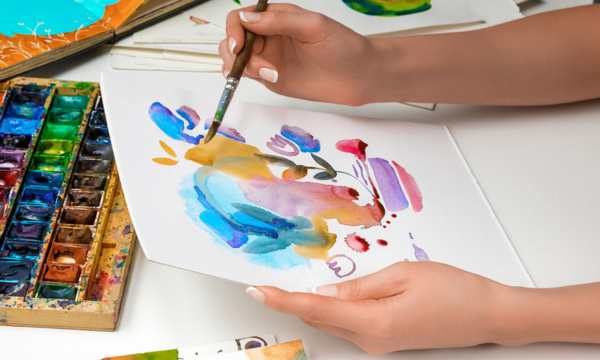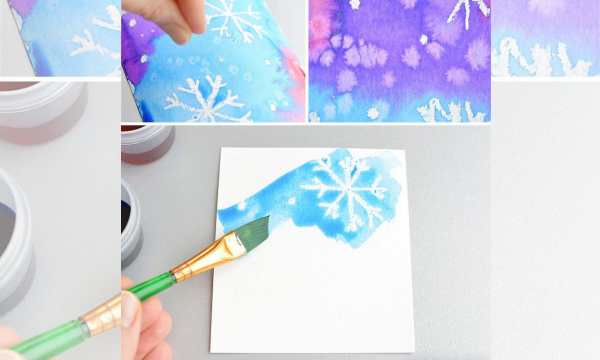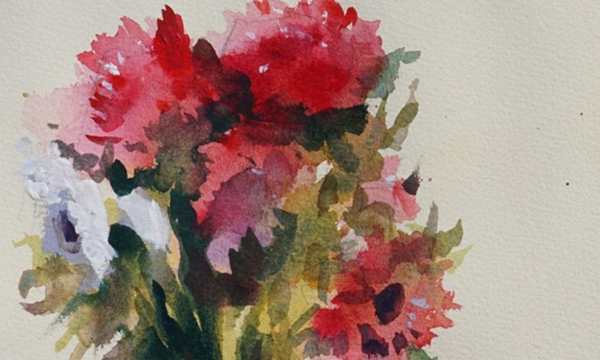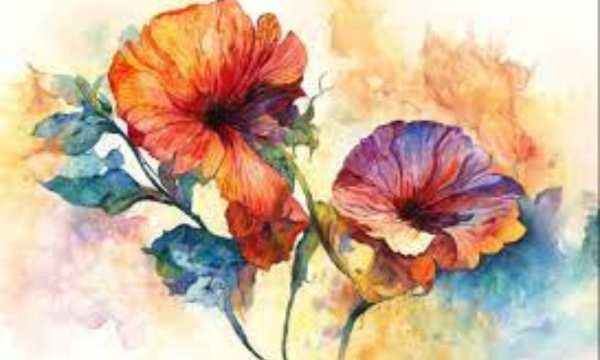Watercolor painting is a beautiful and expressive art form that has been loved for hundreds of years.
Ad
Its fluidity and vibrant colors make it a great way for people just starting to explore their creativity. This book will teach you the basic skills, materials, and ideas of watercolor painting, giving you a solid foundation for exploring the art.
1. Materials
Before you start painting with watercolor paint, you must have the right supplies. To get you started, here’s a simple list:
Ad
- Watercolor paper: For watercolor painting, choose sturdy, acid-free paper made specifically for watercolor painting. The thickness prevents the paper from wrinkling when it gets wet.
- Watercolor Paints: Create a set of high-quality watercolor paints in different colors. Beginners can use professional grade or student grade paint.
- Brushes: Invest in a range of brushes, such as round brushes for details, flat brushes for washes, and larger brushes for rough strokes. It’s best to use a natural bristle brush, but synthetic bristle brushes also work well.
- Palette: You will need a mixing palette with holes for diluting and mixing colors. You can also use a ceramic plate or palette made specifically for watercolor painting.
- Water containers: You should have at least two water containers. One should be used to clean your brush and the other should be used to moisten your paint.
2. Simple Method
- Wet-on-wet technique: Moisten the paper with clean water before painting. The colors on the paper flow smoothly into each other, creating a soft and atmospheric effect.
- Dry brushing technique: To give paper texture, dry brushing is used on dry paper. You can use this method to add details or create interesting textures in your painting.
- Cleaning: When cleaning, apply a thin layer of paint to a large surface. You can use a flat wash for a smooth color change, or a gradient wash for a smooth transition from light to dark.
- Layering: Because watercolors are transparent, you can add layers of color to make them look more complex. To prevent the color from bleeding, wait for each layer to dry before adding the next.
- Masking Fluid: Use masking fluid to preserve white areas on the paper. Apply it before painting and when the paint is dry, remove the masking fluid to reveal the unpainted paper.
- Moving: While the paint is still wet, you can use a clean, damp brush or paper towel to move the color. This method is useful for adding highlights or fixing errors.
- Salted texture: Sprinkle salt over wet paint to create an interesting texture. The salt absorbs the water, causing the color to fade and a unique pattern to be created.
3. Color Theory
Every artist needs to understand the basics of color theory. When you paint with watercolor paint, you mix colors on a palette or paper. Here are some key ideas:
Ad
- Main colors: The main colors are red, blue, and yellow. You can’t make them by mixing other colors, all other colors are built on top of them.
- Secondary colors: When you mix two primary colors, you get secondary colors such as green, orange, and purple.
- Tertiary Colors: These are the six colors you get when you mix a primary color with a close secondary color.
- Complementary Colors: When two colors are next to each other on the color wheel, we call them complementary colors. Examples of complementary colors are red and green or blue and orange. When you use them together you get contrast and color.
- Analogous Colors: Blue, teal, and green are all analogous colors because they are next to each other on the color wheel.
4. Practice Exercises
- Color Mixing: Try mixing different colors on your palette to see how they work together. Mix primary and secondary colors to create a color chart.
- Gradient Washes: Practice smooth gradient washes with paint from light to dark. This method is necessary to make the sky and background look realistic.
- Simple Landscape: First create a simple landscape using simple shapes. Note the wet-on-wet approach for the air and the layered approach for the ground.
- Still Life: Compose and draw a simple still-life scene. Light and shadow are important, and by practicing layering you can give things depth.
- Abstract Exploration: Use your imagination and create some abstract watercolor paintings. Try different methods and see where your imagination takes you.

Conclusion
Watercolor is a way to discover and express yourself. As you learn the basics, experiment with colors, and improve your skills, you’ll discover your style. Remember, mistakes are how you learn, so enjoy the process and the beautiful, unpredictable world of watercolor. If you practice hard, you will enjoy and feel good about creating your watercolor masterpieces.
FAQs
1. What is watercolor painting?
Watercolor is an art style that uses pigments mixed with water to create colorful and expressive works of art. It is known for its softness and clarity and allows you to create many different textures and effects.
2. What do you need to start watercolor painting?
Watercolor paper, watercolor paint, brushes (round, flat, and larger), a palette, and a water container are all things you will need to start painting. Masking fluid, salt, and a mixing palette are all extras you can use.
3. What types of paper can be used for watercolor painting?
You should use sturdy, acid-free watercolor paper made specifically for this medium. Due to its thickness, the paper does not bend when in contact with water.
4. What brushes can be used for watercolor painting?
It’s best to use a natural bristle brush, but a good quality synthetic brush will also get the job done. Use a round brush for details, a flat brush for cleaning, and a larger brush for larger strokes.
5. What does “wet on wet” mean?
When using the wet-on-wet method, the paper must first be moistened with clean water. This allows the colors to flow smoothly into each other across the paper, creating a soft and atmospheric effect.
6. What are some ways to add texture to watercolor paintings?
Texture can be added using dry brushing techniques, salt texturing (spreading salt over wet paint), or lifting (using a clean, damp brush to remove wet paint).


